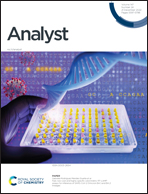An electrochemical sensor based on AuPd@FexOy nanozymes for a sensitive and in situ quantitative detection of hydrogen peroxide in real samples†
Abstract
The hydrogen peroxide (H2O2) levels in living organisms and environment have strong effects on many biological processes inducing cell apoptosis/cell necrosis and wound disinfection. Therefore, it is important to have an accurate and in situ detection of H2O2. Herein, an AuPd@FexOy nanozyme-based electrochemical (EC) sensor (termed as AuPd@FexOy NPs/GCE) with good stability and anti-interference ability has been prepared for the detection of H2O2 by differential pulse voltammetry (DPV) and chronoamperometry dual-measurement modes. The AuPd@FexOy NPs/GCE exhibits good linear relationships in the ranges from 13.0 to 6.0 × 103 μM (DPV measurement) and 50 to 1.0 × 103 μM (chronoamperometry measurement), low detection limits (LODs) of 1.6 μM (DPV measurement) and 3.0 μM (chronoamperometry measurement) and high sensitivities of 83.8 nA μM−1 cm−2 (DPV measurement) and 120.7 nA μM−1 cm−2 (chronoamperometry measurement). The practicability of the as-prepared AuPd@FexOy NPs/GCE has been demonstrated by an in situ real-time detection of H2O2 released from adherent living MCF-7 cells triggered by varying amounts of N-formyl-L-methionyl-L-leucyl-L-phenylalanine (FMLP) from 0.5 to 3.0 μM and the quantitative determination of H2O2 in commercial disinfectants.



 Please wait while we load your content...
Please wait while we load your content...